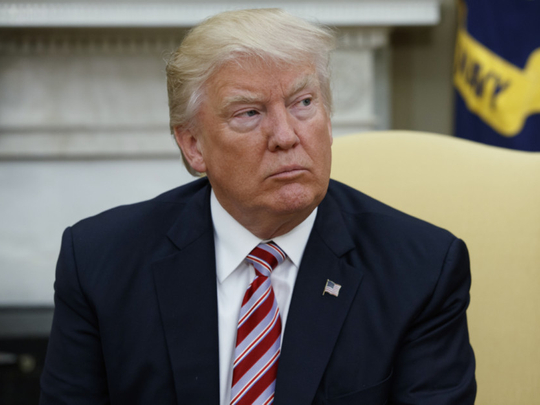
How to define fake news? Before I offer a draft definition and seek readers’ feedback, here is why the task feels urgent.
Partly by deploying the term fake news, the serving US president is challenging the legitimacy of institutional journalism.
We know the 2016 US presidential election was distorted by fake news. An organised mix of hacking, online dissemination and fakery may yet have its effects on French democracy in the forthcoming legislature elections, after having been muted, it seems, in its impact on the country’s recent presidential run-off. UK general election campaigning is under way in earnest, and Germany votes later this year.
A readers’ editor is made aware of journalism’s imperfections every day. Increasingly, complainants allege that the piece of journalism with which they are taking issue is fake news. But it isn’t fake, even if the piece turns out to be flawed. The distinction matters.
To equate flawed journalism with fake news corrodes a long-standing notion on which democracies rely: that there can be such a thing as a shared approximation of truth resting on verifiable facts and corrected or clarified incrementally.
I also daily see journalism’s strengths, and the pressures on journalists, both directly, from those who may want to shape or shut down disclosures, and indirectly, from the shuddering impact of technological change on the commercial underpinnings and traditional practices of media entities.
Journalism has evolved alongside other essential elements of democratic life, nourishing and being nourished by them. Granted, some individuals and some journalism institutions at times do harm, especially when undue concentrations of ownership and control are tolerated. And granted, fake news is not new.
But, viewed in a long and wide perspective, the record shows that professional journalism — first in print, then joined by broadcasting, and now converging on digital platforms — has contributed and still contributes to better informed electorates, more responsive legislatures, more accountable executive government and, through the routine reporting of the courts, the practical operation of the principle of open justice.
Unlike the messaging that bots and algorithms, guided by harvested personal data, sprinkle through individuals’ social media feeds, institutional journalism is open to collective view, challenge and judgement.
The combined output of professional journalism is a commons of sorts. Keep that in focus as we struggle to understand the impact on democratic processes of campaigns that atomise electorates and distribute messages in the dark.
Shared verifiable facts are a precondition for legitimacy in public policy debate, deliberation and decision. By the light of reliable information, both action and inaction are held accountable, decisions are assessed, debates are settled or perhaps revisited, and votes are cast.
Institutional journalism produces an approximation of truth, limited by time, access and human frailty. In the digital era, journalism by professionals is increasingly augmented by non-professionals, “the people formerly known as the audience”, working in various new models of cooperation.
In the absence of a shared approximation of truth, democratic governance under the rule of law gets much harder, and power alone starts to determine truth.
Here is my current draft definition of fake news: Fake news means fictions deliberately fabricated and presented as non-fiction with the intent to mislead recipients into treating fiction as fact or into doubting verifiable fact.
* “Fictions” is meant to distinguish fake news from items which have a kernel of truth but are exaggerated, out of proportion, in the cliche “sensationalised”.
* “Fabricated” emphasises the made-up, manufactured aspect of fake news.
* “Deliberately” and “intent” draw attention to how fake news is purposeful, and help to show it is distinct from the flawed journalism that can result from haste, carelessness, partiality, conflicts of interest or the successful spin of others.
* “Presented as non-fiction” focuses on the premeditation and calculation which often seem to characterise the originators of fake news, as distinct from the people who simply spread it unthinkingly.
* “Mislead” indicates seriousness of purpose and distinguishes fake news from, say, entertainment, pranks or satire.
* “Treating fiction as fact” and “doubting verifiable fact” look to consequences. These seem to be the two main political purposes of those who create fake news.
Other definitions can be found in submissions to a recent UK parliamentary committee inquiry into the problem. In Australia, a newly announced Senate committee inquiry into journalism will probably hear more suggestions.
Many organisations are analysing and tackling the issue. Facebook says it wants to as well and, to its credit, it recently advertised in UK newspapers 10 “tips for spotting false news” (undefined, but described).
It was odd to see this cyber-giant communicating in ink on paper. A reader sent me a tear-out of the ad, circling in pen the second tip (“look closely at the URL”) and asked what it meant. It is a reminder that print-preferring readers, as much as Facebook’s vast, global and digitally acclimatised population, are full members of a polity, stakeholders in a democracy under pressure.
In my view fake news, in this transitional era from analogue to digital, presents a threat so serious that the long-standing codes of ethics of professional journalism should have a new obligation added: expose fake news as fake.
— Guardian News & Media Ltd
Paul Chadwick is the Guardian’s readers’ editor








